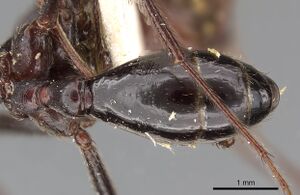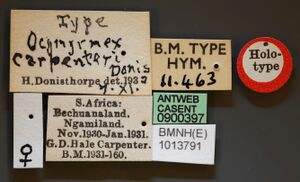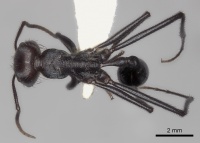Ocymyrmex picardi
| Ocymyrmex picardi | |
|---|---|

| |
| Scientific classification | |
| Kingdom: | Animalia |
| Phylum: | Arthropoda |
| Class: | Insecta |
| Order: | Hymenoptera |
| Family: | Formicidae |
| Subfamily: | Myrmicinae |
| Tribe: | Crematogastrini |
| Genus: | Ocymyrmex |
| Species: | O. picardi |
| Binomial name | |
| Ocymyrmex picardi Forel, 1901 | |
| Synonyms | |
| |
| At a Glance | • Ergatoid queen |
A very conspicuous species, the largest known in the genus, picardi appears to be quite widely distributed in southern Africa.
Identification
A member of the weitzeckeri group. As the largest species of the genus, its size alone makes picardi unlikely to be confused with any other Ocymyrmex.
Keys including this Species
Distribution
Latitudinal Distribution Pattern
Latitudinal Range: -12.38333° to -26.125°.
| North Temperate |
North Subtropical |
Tropical | South Subtropical |
South Temperate |
- Source: AntMaps
Distribution based on Regional Taxon Lists
Afrotropical Region: Angola (type locality), Botswana, Namibia, South Africa, Zimbabwe.
Distribution based on AntMaps
Distribution based on AntWeb specimens
Check data from AntWeb
Countries Occupied
| Number of countries occupied by this species based on AntWiki Regional Taxon Lists. In general, fewer countries occupied indicates a narrower range, while more countries indicates a more widespread species. |

|
Estimated Abundance
| Relative abundance based on number of AntMaps records per species (this species within the purple bar). Fewer records (to the left) indicates a less abundant/encountered species while more records (to the right) indicates more abundant/encountered species. |

|
Biology
Recent observations at Tosca in the northern Cape, South Africa (Bolton and Marsh 1989) indicate that multiplication of colonies is by fission of an existing nest. In December 1986 a considerable amount of recruitment in one direction was observed from one nest of picardi. Investigation revealed that the ants were relocating to another nest 150m away. The nest from which the ants were being recruited had a large nest disk and midden of arthropod remains and was clearly an old, well established nest. In contrast, the nest to which the ants were moving had a smaller disk and no midden, and appeared to be more recently excavated. Traffic between the two nests continued for a day and thereafter ceased, and normal foraging activity was seen at both nests. Nest structure is similar to Ocymyrmex foreli: one ground entrance that opens into a vertical tunnel which terminates in a broad chamber at a depth of about 30 cm. Other brood and food chambers branch off from the tunnel at various intermediate levels.
Diet
Observations by Marsh (as stated in Bolton and Marsh, 1989) indicate the diet is 70 per cent arthropods, much of it live termites, and the remainder consists of plant material.
Morphology
Holldobler, Stanton and Engel (1976) reported the discovery of a of a previously undetected gastral exocrine system in workers of O. picardi and a few North American deserticolous ants belonging to the genus Aphaenogaster. Kugler (1978) later named this structure the pygidial gland. The gland consists of a number of cells located under the intersegmental membrane between gastral tergites 3 and 4 ( = abdominal tergites 6 and 7), with ducts through the membrane. In O. picardi and some other myrmicines the gland is associated with a special cuticular area on the base of the pygidium (gastral tergite 4), on the section of the scelerite which in life is overlapped by the apex of the third gastral tergite.
Castes
Forder and Marsh (1989) noted from dissections that the ergatoid queens have much larger ovaries than workers (36 vs 2 ovarioles).
Queen
Images from AntWeb
    
| |
| Holotype of Ocymyrmex carpenteri. Worker. Specimen code casent0900397. Photographer Ryan Perry, uploaded by California Academy of Sciences. | Owned by NHMUK, London, UK. |
Nomenclature
The following information is derived from Barry Bolton's Online Catalogue of the Ants of the World.
- picardi. Ocymyrmex picardi Forel, 1901d: 306 (w.) ANGOLA. [Also described as new by Forel, 1903e: 561.] Senior synonym of carpenteri: Bolton, 1981b: 275.
- carpenteri. Ocymyrmex carpenteri Donisthorpe, 1933b: 195 (q., not w.) BOTSWANA. Junior synonym of picardi: Bolton, 1981b: 275.
Unless otherwise noted the text for the remainder of this section is reported from the publication that includes the original description.
Description
Worker
Bolton (1981) - TL 11.6-12.6, HL 2.52-2.80, HW 2.44-2.68, CI 93-97, SL 2.30-2.52, SI 90-98, PW 1.60-1.80, AL 3.40-3.68 (20 measured).
Very large species. Anterior clypeal margin with a conspicuous median semicircular impression which is flanked by a small tooth on each side. Maximum diameter of eye 0.46-0.51, about 0.19-0.20 x HW. With the head in full-face view the occipital margin varying from approximately transverse to feebly indented medially. Promesonotum in profile evenly and broadly convex, sloping posteriorly to the propodeal dorsum which, in this species, is not as strongly depressed below the level of the promesonotum as is usual elsewhere in the genus. Propodeal dorsum rounding broadly and evenly into the declivity. Metapleural lobes rounded, visible in profile, not concealed by the bulge of the metapleural glands. Petiole node in dorsal view as broad as or broader than long. Postpetiole slightly longer than broad in dorsal view, discounting the anterior articulatory portion. Base of first gastral tergite narrow, in dorsal view no broader than the postpetiole, but the sides evenly diverging from their junction with the postpetiole, without a roughly parallel-sided neck. Dorsum of head finely, densely and more or less evenly longitudinally costulate, the costulae rarely approximately straight, much more commonly diverging behind towards the occipital corners. Infrequently a few transverse costulae may be present occipitally. Individual costulae commonly irregular, tending to be narrowly sinuate or wavy, especially away from the midline of the dorsum. Ground-sculpture a fine dense punctulation. Dorsal alitrunk and propodeal declivity transversely rugose except for the space between the mesothoracic spiracles and part of the pronotal dorsum, where sculpture is longitudinal to oblique. Sides of alitrunk rugose, the sculpture less regular on the pleurae than on the sides of the pronotum. Petiole with transverse rugae ventrally, below the node, and also with a few dorsally on the peduncle in front of the node. On the node itself sculpture is usually restricted to a superficial patterning with vestigial rugulae, but occasionally one or two stronger transverse rugulae may be present dorsally, or vertically on the sides, or both. Postpetiole unsculptured except for superficial patterning. All dorsal surfaces of body with scattered strong dark hairs which are reddish brown to blackish; those on the first gastral tergite very sparse and much shorter than those on the alitrunk. Colour very dark red to black, the head usually slightly lighter in shade than the alitrunk and the gaster generally darker.
Type Material
Bolton (1981):
Lectotype worker, Angola: Mossamedes, Cubango-Cuito (Musee d'Histoire Naturelle Genève), here designated [examined].
Ocymyrmex carpenteri Holotype female [not worker], Botswana: Ngamiland, ix.1930-i.1931 (G. D. H. Carpenter) (The Natural History Museum) [examined].
The number of specimens in the original syntypic series of picardi was not stated by Forel. At the time of this study only two specimens, mounted on a single pin, were found bearing the label 'typus'. Of these the top specimen is a worker and fits the original description perfectly; it is here designated as lectotype of picardi. The lower specimen, now remounted on a separate pin, is a female and is not mentioned in the original description.
The female (queen) of picardi was first described by Donisthorpe as a worker, under the name of carpenteri. The holotype matches the female in the same series as the picardi lectotype and the synonymy is thus absolute. The female of picardi fits the description given above and its dimensions fall within the ranges given. The only differences from the worker lie in those characters discussed under the generic diagnosis, namely the broader straighter margins to the frontal lobes, broader antennal scapes and sharp transverse sculpture on the posterior portion of the dorsum of the head.
References
- Donisthorpe, H. 1933b. Descriptions of three new species of Formicidae, and a synonymical note. Ann. Mag. Nat. Hist. 10(11): 194-198.
- Bolton, B. 1981. A revision of six minor genera of Myrmicinae (Hymenoptera: Formicidae) in the Ethiopian zoogeographical region. Bulletin of the British Museum (Natural History) Entomology. 43:245-307. (page 275, Senior synonym of carpenteri)
- Bolton, B. and A. C. Marsh. 1989. The Afrotropical thermophilic ant genus Ocymyrmex (Hymenoptera: Formicidae). Journal of Natural History. 23:1267-1308.
- Forder, J. C. and A. C. Marsh. 1989. Social organization and reproduction in Ocymyrmex foreli (Formicidae: Myrmicinae). Insectes Sociaux. 36:106-115.
- Forel, A. 1901g. Einige neue Ameisen aus Südbrasilien, Java, Natal und Mossamedes. Mitt. Schweiz. Entomol. Ges. 10: 297-311 (page 306, worker described)
- Hölldobler, B., R. C. Stanton, and H. Engel. 1976. A new exocrine gland in Novomessor (Hymenoptera: Formicidae) and its possible significance as a taxonomic character. Psyche. 83:32-41.
- Jansen, G., Savolainen, R. 2010. Molecular phylogeny of the ant tribe Myrmicini (Hymenoptera: Formicidae). Zoological Journal of the Linnean Society 160(3), 482–495 (doi:10.1111/j.1096-3642.2009.00604.x).
- Tseng, S.-P. 2020. Evolutionary history of a global invasive ant, Paratrechina longicornis (Dissertation_全文 ). Ph.D. thesis, Kyoto University.
References based on Global Ant Biodiversity Informatics
- Arnold G. 1916. A monograph of the Formicidae of South Africa. Part II. Ponerinae, Dorylinae. Annals of the South African Museum. 14: 159-270.
- Bolton B. 1981. A revision of six minor genera of Myrmicinae (Hymenoptera: Formicidae) in the Ethiopian zoogeographical region. Bulletin of the British Museum (Natural History). Entomology 43: 245-307.
- Bolton B., and A. C. Marsh. 1989. The Afrotropical thermophilic ant genus Ocymyrmex (Hymenoptera: Formicidae). Journal of Natural History 23: 1267-1308.
- Forel A. 1903. Einige neue Ameisen aus Sud-Angola. Pp 559-564, in: Baum, H. Kunene-Sambesi-Expedition, 1903. Berlin: Verlag des Kolonial-Wirtschaftlichen Komitees, 593pp.
- Forel A. 1910. Zoologische und anthropologische Ergebnisse einer Forschungsreise im westlichen und zentralen Südafrika ausgeführt in den Jahren 1903-1905 von Dr. Leonhard Schultze. Vierter Band. Systematik und Tiergeographie. D) Formicidae. Denkschriften der Medizinisch-Naturwissenschaftlichen Gesellschaft zu Jena 16: 1-30.
- IZIKO South Africa Museum Collection
- Koch F., and K. Vohland. 2004. Ants along a southern African transect - a basis for biodiversity change monitoring (Insecta, Hymenoptera, Formicidae). Zoosystematics and Evolution 80(2): 261-273.
- Santschi F. 1925. Formicidae. Mission Rohan-Chabot. 4(3): 159-168.
- Santschi, F. "Résultats de la Mission scientifique suisse en Angola, 1928-1929. Formicides de l'Angola." Revue Suisse de Zoologie 37 (1930): 53-81.
- Stitz H. 1923. Hymenoptera, VII. Formicidae. Beiträge zur Kenntnis der Land- und Süsswasserfauna Deutsch-Südwestafrikas 2: 143-167.
- Wheeler W. M. 1922. Ants of the American Museum Congo expedition. A contribution to the myrmecology of Africa. VIII. A synonymic list of the ants of the Ethiopian region. Bulletin of the American Museum of Natural History 45: 711-1004

